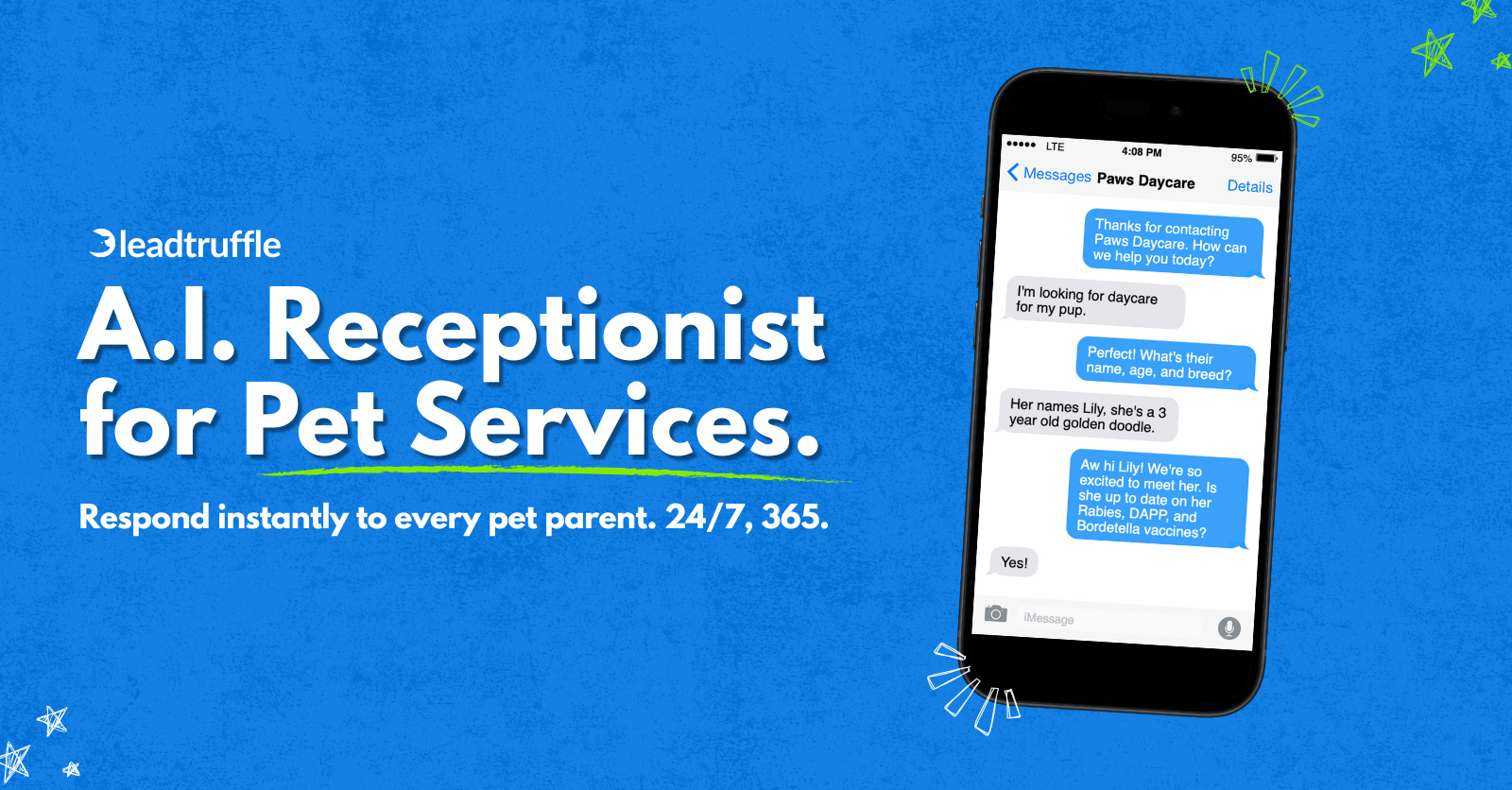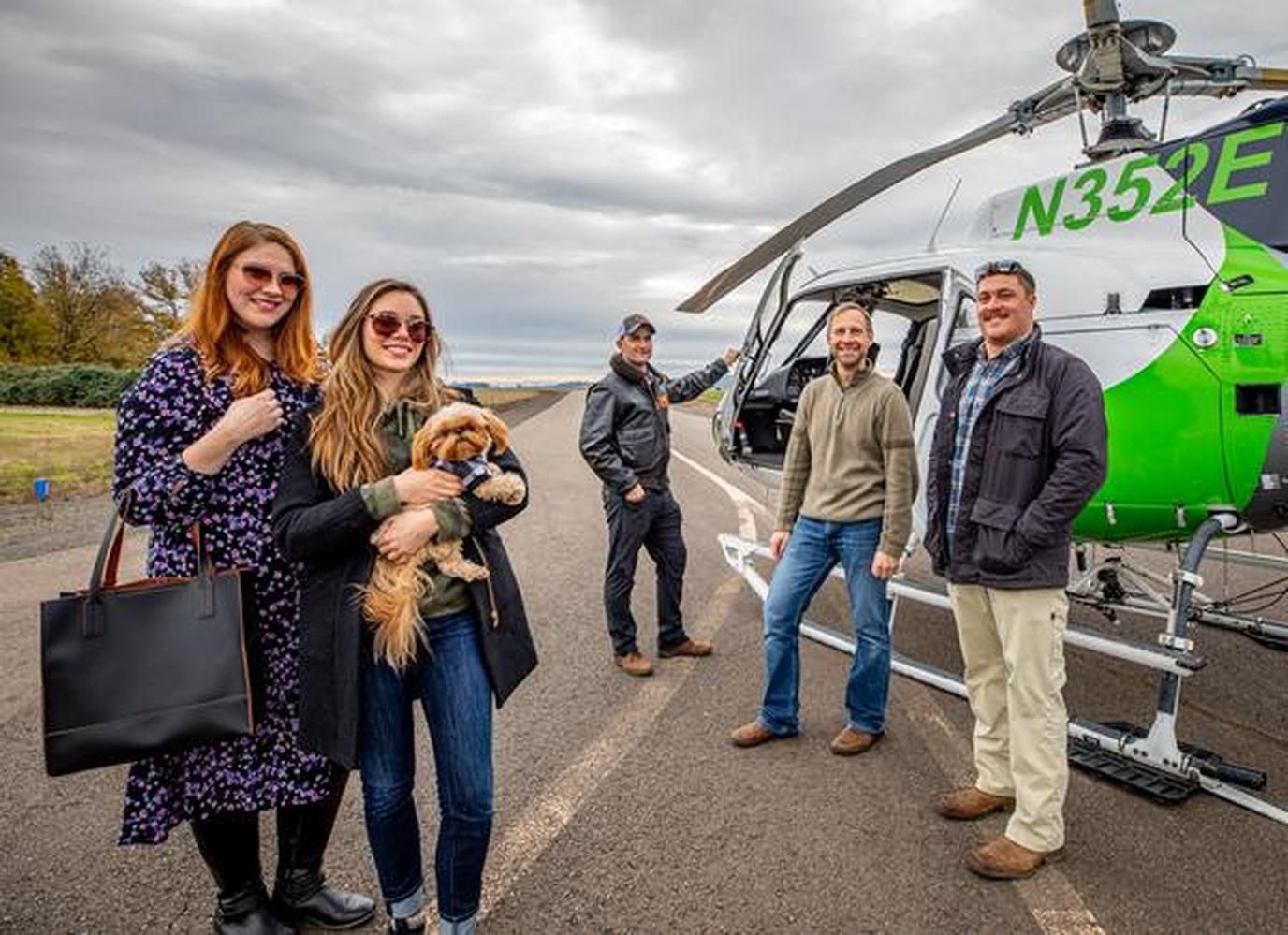- The Woof
- Posts
- Pet Wellness Is Crowded. Experiences Are Up for Grabs.
Pet Wellness Is Crowded. Experiences Are Up for Grabs.
Core memories, not calming chews, might be your brand’s biggest growth opportunity.

Issue #219
July 23rd, 2025
Meet Your 24/7 AI Receptionist for Pet Services
Running a dog daycare, grooming salon, vet clinic, or pet boarding business? You know the drill - calls at all hours, inboxes full, and staff stretched thin.
LeadTruffle is your A.I. receptionist built for pet services. It handles inquiries from your website, texts back missed calls, and even answers the phone using smart A.I. voice - all 24/7. It filters spam, responds to real leads fast, and manages routine questions so your team can focus on pets and their parents.
“LeadTruffle has completely changed how we handle new inquiries at Cats Only VC. Within the first 24 hours, we booked 12 new appointments—without a single phone call. It’s like having a 24/7 receptionist who actually knows what they’re talking about.” - Cats Only Vet Clinic
Special Woof News Offer:
Start with a 14-day free trial – no credit card required.
Get your first full month free when you upgrade.
Quick Hits:

It’s no secret (we’ve talked about it before), preventative pet care is booming: 53% of dog owners now give their dogs vitamins or supplements, up 6% from last year.
Venture capital is even chasing dog longevity pills – startup Loyal’s anti-aging drug for senior pups just cleared an FDA hurdle toward approval. But this gold rush in “functional” pet health is turning into a red-ocean challenge.
New functional SKUs (supplements, special diets, anti-aging remedies) are multiplying faster than chew toys, digital ad costs are soaring, and industry giants are muscling in by launching their own lines or gobbling up indie brands.
Pet founders face a sobering reality: standing out with another miracle pill or powder is getting ruff.
The red-ocean squeeze is real.
Legacy players like Nestlé Purina launched EverRoot (a line of dog supplements with organic ingredients and celebrity backing) with the help of Laila Ali. Chewy introduced 20 proprietary wellness supplements under its Vibeful.
Even flashy DTC darlings are getting subsumed – Zesty Paws, a pet supplement startup, sold for a whopping $610 million in 2021. When everyone is selling functional “boosters” for Fido’s joints or coat, trust becomes hard to earn and customer acquisition costs (CAC) spiral higher than a Great Dane’s reach.
Instead of fighting tooth-and-nail in this crowded, medicinal market, savvy pet brands can zig where others zag: toward experience-driven “core memory” products and services that win hearts (and wallets) in more playful ways.
The Functional Arms Race
The pet health category has become an arms race of ever-more specialized pills and kibbles.
Consider a couple of recent power moves:
Biotech Boosters: Loyal – the VC-backed startup mentioned above – is developing a daily pill to extend canine lifespan. Earlier this year it won FDA’s sign-off on “reasonable expectation of effectiveness,” meaning it could start selling by year end. A longevity drug for dogs sounds like sci-fi, but with $150+ million in funding behind Loyal, it’s clear how hot the functional trend has become. If pet parents are willing to add a life-extension pill to Spot’s routine, you can bet competition for that prevention dollar will be fierce.
Indie Darlings Go Mainstream: Emerging brands are scaling fast to grab share, but even they’re finding life in the functional lane competitive. Take Jinx, a modern dog nutrition startup known for superfood kibble and treats. Jinx quickly expanded into 10,000+ retail doors (Walmart, Target, PetSmart, etc.) as of 2025, riding demand for functional, clean-label pet food. Its treats boast probiotics and “bone broth” for health – now available everywhere from Chewy to Target’s shelves. When a 3-year-old startup already has national big-box placement, you know the functional trend is mainstream. That scale also means massive marketing spend. Jinx’s retail push and nearly $100M revenue run-rate came with big fundraising and celebrity investors, resources most small brands lack.
In this arms race, trust and CAC are the killjoys for newcomers.
Pet parents are inundated with similar-sounding health claims (“backed by vets,” “human-grade,” “proven results”), so winning credibility on a tight budget is as hard as teaching a cat to fetch.
At the same time, advertising in the pet wellness niche has gotten expensive – every supplement startup is bidding on the same Google keywords and Facebook audiences, driving up costs.
Larger players can afford prime influencers or vet endorsements, further squeezing indie brands’ ROI on ads.
The upshot: a small brand selling yet another hip-and-joint chew is swimming in a red ocean of lookalikes. Unless you have a truly novel formula and deep pockets, playing the functional features game is an uphill climb.
The Zig Opportunity: Core-Memory Experiences
So, what’s a pet brand to do?
Zig into creating core memories instead of more pills/supplements/treats.
“Core-memory” products and services are splurges that create emotional rituals – the kind of experiences that pet parents will cherish (and happily pay for) because they strengthen the human–animal bond.
Think beyond health function to heartstrings: the birthday “pup-cake” that makes your dog’s face light up, the first hiking trip with your rescue dog, the annual “gotcha day” boxes or special outings.
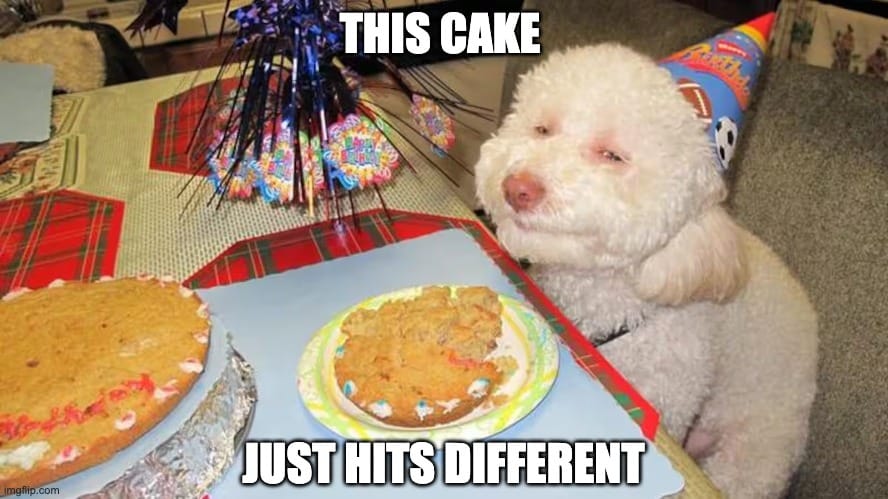
These aren’t everyday needs; they’re occasions – and often, they’re Instagrammably (is that a word?) joyous.
The data shows owners are already spending big on celebratory moments.
Pet parties and special events have surged in popularity alongside the humanization trend. For example, a recent UK survey by Moonpig found 64% of pet owners now celebrate their pets’ birthdays or adoption anniversaries, with many throwing actual parties or buying gifts.
In fact, owners spend an average of £80 (about $108) a year just on pet birthday presents in the UK – totaling over $2.3 billion annually for that market alone.
Millennials & Gen Z are leading the charge: in the survey, a whopping 83% of Gen Z pet parents said they’ve thrown a pet birthday celebration.
Similarly, U.S. trends reflect this “pet-as-family” pampering: the American Pet Products Association noted that hosting holiday or birthday parties for cats jumped 250% since 2018 and over three-quarters of all pet owners give their pets gifts for holidays or birthdays.
In short, consumers are already in the mindset of creating special moments with their animals – and that’s the green space for brands to innovate.
Core-memory offerings tap into this emotional spend by focusing on experiences and rituals rather than daily nutrition.
It’s selling joy and connection, not just health or convenience. A dog won’t remember that he got an omega-3 capsule in his breakfast, but he might just wag for life about that doggie ice-cream sundae you served on his “Gotcha Day.”
For brands, these products and services can foster intense loyalty (just look at what Starbucks did with the pup cup) and word-of-mouth, precisely because they’re unique and shareable.
Let everyone else fight in the red ocean of functional claims; you can ride a different wave – the experience economy of pet parenting.
Experiential “Spoil” Services
What might these core-memory experiences look like?
The possibilities are as fun as they are varied. Pet owners are already seeking out ways to spoil their furry ones with outings and activities that go beyond the dog park.
Here are some examples of experience-first offerings gaining traction:
🥾 Outdoor Adventures: Dog-friendly hiking retreats and camping getaways are booming. Over 53% of campers now bring their dogs on trips, and campgrounds have taken note – dog parks are now the third most requested amenity at campgrounds (right after Wi-Fi and pickleball courts).
Entrepreneurs are organizing guided group hikes for dogs and owners or weekend “canine adventure” camps where pups and people learn trail skills during the day and roast (dog-safe) s’mores at night.
🛝 Private Playgrounds: Not every dog loves a crowded park, which is why services like Sniffspot have exploded.
Sniffspot lets you rent someone’s fenced yard or private land by the hour – essentially an Airbnb for off-leash dog time.
The concept has caught fire: Sniffspot now has 20,000+ private dog parks listed and over 100,000 users booking play sessions. Pet parents are willing to pay $10-$20 an hour for a safe, exclusive romp for their dog.
Brands can piggyback on this trend by curating special play locales (e.g., a pop-up puppy playground with agility equipment and photo ops) or offering subscriptions for monthly “adventure yard” access. It’s all about giving dogs space to be dogs – a memorable treat for cooped-up city pups.
🍷 Canine Culture & Cuisine: Why should humans have all the foodie fun?
A niche but growing experience is cooking classes for owners and pups to bake treats or even cook dog-friendly meals together.
Imagine a weekend workshop where you and your dog, sporting matching aprons, learn to make organic pup-cakes or “paw-sta” from a pet nutrition chef.
Pet bakeries are dabbling in this, turning treat-making into a hands-on event for dog moms and dads. Likewise, dog-friendly brewery and winery tours have become popular social outings.
In California’s wine country, you can join guided winery tours that specifically cater to dogs and their owners – one tour in Paso Robles chauffeurs you and your pup to multiple dog-welcoming vineyards in the state’s fastest-growing wine (yes, helicopter wine tours with dogs exist!).
In Texas Hill Country, a Wine Shuttle hits 14 dog-friendly wineries along a route, even allowing small dogs on board for the tasting.
Craft breweries nationwide host “Yappy Hours,” and some have dog play areas on-site. These experiences combine owners’ leisure with pets’ inclusion, creating core memories (and great social media pics to boot).
💅 Luxury & Leisure: The high end of pet pampering continues to reach new heights. Think private dog beach days where a resort rents out a stretch of beach for off-leash play, complete with canine cabanas and doggie popsicles.
Or luxury pet spas that offer side-by-side treatments for you and your dog – your pup gets a blueberry facial and massage while you enjoy a human spa service. Upscale pet hotels already offer “spa days” with aromatherapy baths and pawdicures; some report waitlists for their most indulgent packages.
@doggystylz_petgrooming #pomeranian #grooming #petgrooming #petgroomer #dog #puppy #cute #spaday #fyp #groomer #coralsprings #doggroomer #bath
While hard numbers on spa usage are scarce, the pet services market (which includes grooming, boarding, and experiences) is thriving – Rover, the pet‑sitting marketplace, grew its annual bookings 71 % between 2021 (4.2 million) and 2025 (7.2 million) as owners rushed back to professional pet‑care services post‑pandemic.
This is proof that pet parents are happy to shell out for experiences that make both them and their animals feel good.
🤗 Social Impact Outings: Memorable experiences can also come from giving back.
Many owners find purpose and joy in doing good with their pets.
For instance, therapy dog volunteering has become a popular activity – taking your dog to visit nursing homes, schools, or hospitals. Organizations often train and certify therapy dog teams, turning altruism into a bonding experience.
Brands could facilitate “voluntourism” trips (like a day of volunteering at an animal shelter or a park clean-up with your dog) or sponsor therapy dog programs, framing it as an experience that creates positive core memories for owner, pet, and community.
It’s an emotionally rich alternative to yet another product sample giveaway.
In each of these examples, the common thread is experience first, product second.
Sure, there are products embedded (treat kits, travel gear, spa products), but the primary value is the activity and memory created.
Crucially, these experiences are inherently shareable – an adorable “dog birthday party” or scenic hike with your husky is prime content for proud pet parents to post, generating organic buzz that no amount of paid ads can replicate.
Strategy Playbook
For pet brands looking to pivot into core-memory experiences, a strategic approach is key. Here’s a playbook to consider:
✅ Occasion Mapping: Identify the seasonal or life-stage rituals around pets and build offerings for them. Map out a pet’s year – birthdays, “Gotcha Day” adoption anniversaries, Halloween dress-up, summer pool days – and design products or services to enhance those moments.
By aligning with existing pet parent habits (like the surge in pet birthday parties), you tap into pre-existing demand. For example, a company might create a “Birthday Box” bundle (cake mix, party hat, toys) for dogs, or offer seasonal adventure packages (“Fall Foliage Hike with Your Dog” guided tour in October). Planning around occasions ensures your offering is timely and emotionally resonant.
✅ Scarcity & Storytelling: Experiences thrive on exclusivity and narrative.
Use limited-time or limited-quantity tactics to make splurges feel special. This could mean offering only 50 slots for a monthly group dog hike or hosting a quarterly pop-up event that sells out.
Scarcity drives urgency and buzz.
Pair it with rich storytelling – every experience should have a story or theme that owners latch onto. Share the story behind your brand’s experience: highlight customer anecdotes (“Max’s day at our surf-dog clinic became a core memory for his family”) to create FOMO for those who haven’t tried it.
People don’t just buy the service; they buy the story of what it means.
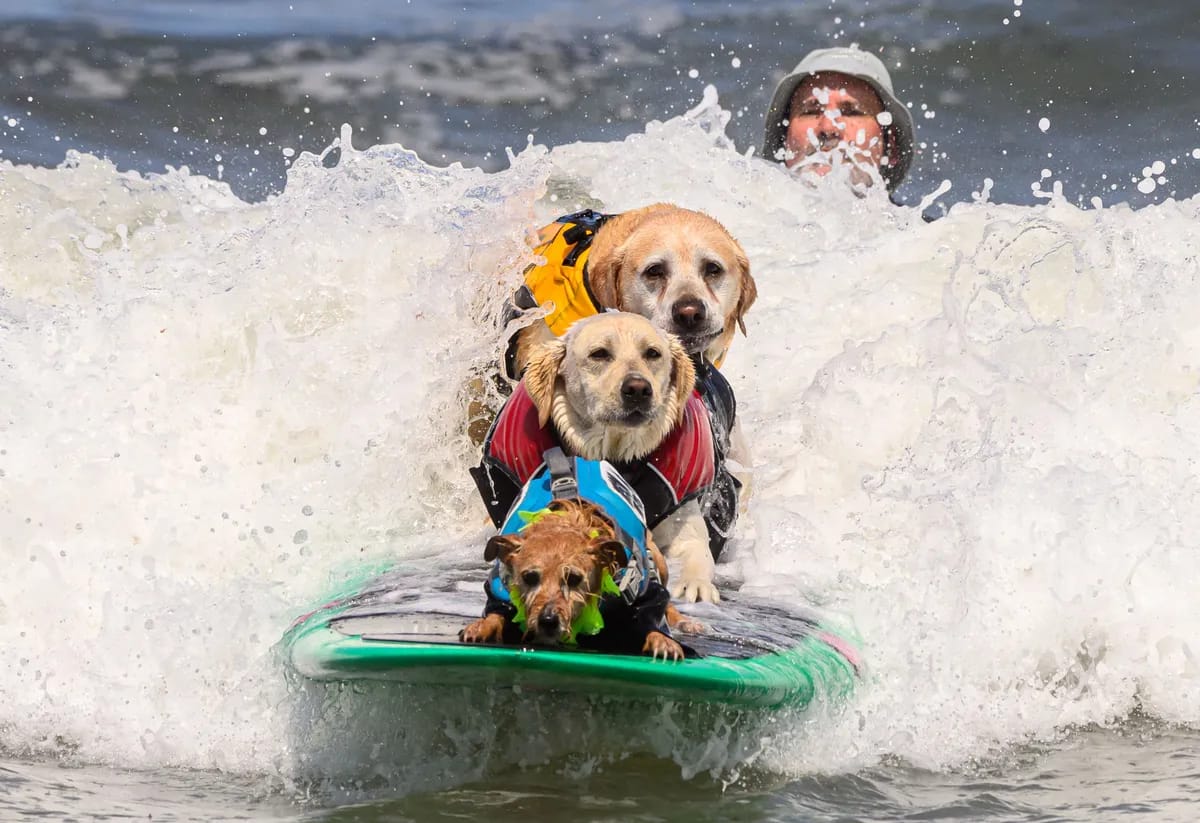
World Dog Surfing Championship
✅ UGC Flywheel: Experiences naturally generate user-generated content.
A huge advantage of going the core-memory route is the free marketing each customer provides. Encourage participants to snap photos, post videos, and share reviews of their dog having a blast. Design the experience with Instagram/TikTok in mind.
These shareable moments turn into testimonials that spread on social media, attracting other pet parents. Over time, this UGC (user-generated content) can lower your CAC because happy customers are doing the evangelizing.
Bonus: This content also deepens loyalty among existing customers, as they love being part of the brand’s story.
✅ Bundled Economics: Experience products can command premium pricing, which helps margins.
Pet parents will pay $50 for a special outing or kit that they’d never pay for a simple toy or treat alone. Bundle physical products with the experience to increase perceived value – for instance, a $200 weekend retreat might include a swag bag of treats, a commemorative video, and a coupon for follow-up services.
The high price per splurge means you don’t need repeat purchases every month to be profitable; a customer might only do a big $300 birthday package once a year, but its margin could outshine a year’s worth of selling $25 supplement containers.
Also consider subscription models around experiences: e.g., a “Monthly Adventures Club” where members pay a flat fee for a curated experience each month (hike one month, training workshop the next, etc.).
By packaging experiences creatively, you ensure each “memory” sold is also financially rewarding.
Risks & Mitigations
Shifting into experiential offerings isn’t without its pitfalls. Brands must proactively address a few key concerns:
Brand Dilution or Credibility: If you’re a brand known for serious health products, a pivot to “party time” could confuse customers or dilute your expert image. Likewise, focusing on experiences might make investors nervous about scalability. Mitigation: tie experiences back to your core mission. Frame them as extensions of pet wellness – after all, mental and emotional health are part of overall wellness. For instance, if you sell supplements for anxiety, hosting calming dog yoga sessions aligns with your calming niche. Communicate to stakeholders that these experiences create a pipeline for loyal customers and UGC-driven growth, complementing product sales rather than cannibalizing them. Start small and pilot a few events to gather data and testimonials, then scale once you prove the concept (nothing eases investor minds like a fully booked event series and great press coverage of your “innovative approach”).
Economic Sensitivity: Experiential purchases are discretionary – in a downturn, pricey pet adventures might be first on the chopping block. Mitigation: build a range of price points and emphasize value. Offer some low-cost or free community events (even if just online meetups or contests) to keep engagement high, and make your high-end offerings feel worth it as rare treats. Also, collect feedback obsessively – ensure customers feel they got more than their money’s worth. Happy customers will come back even if times get tough, because they see your experience as an essential joy (or as a form of escapism), not a frivolous expense.
In a pet market where everyone is chasing longevity and functionality, it’s worth remembering: function matters, but core memories lasts longer. The supplement or prescription will help a pet’s health, but the experience you share with your pet is what sticks in the mind (yours and hopefully the dog’s!).

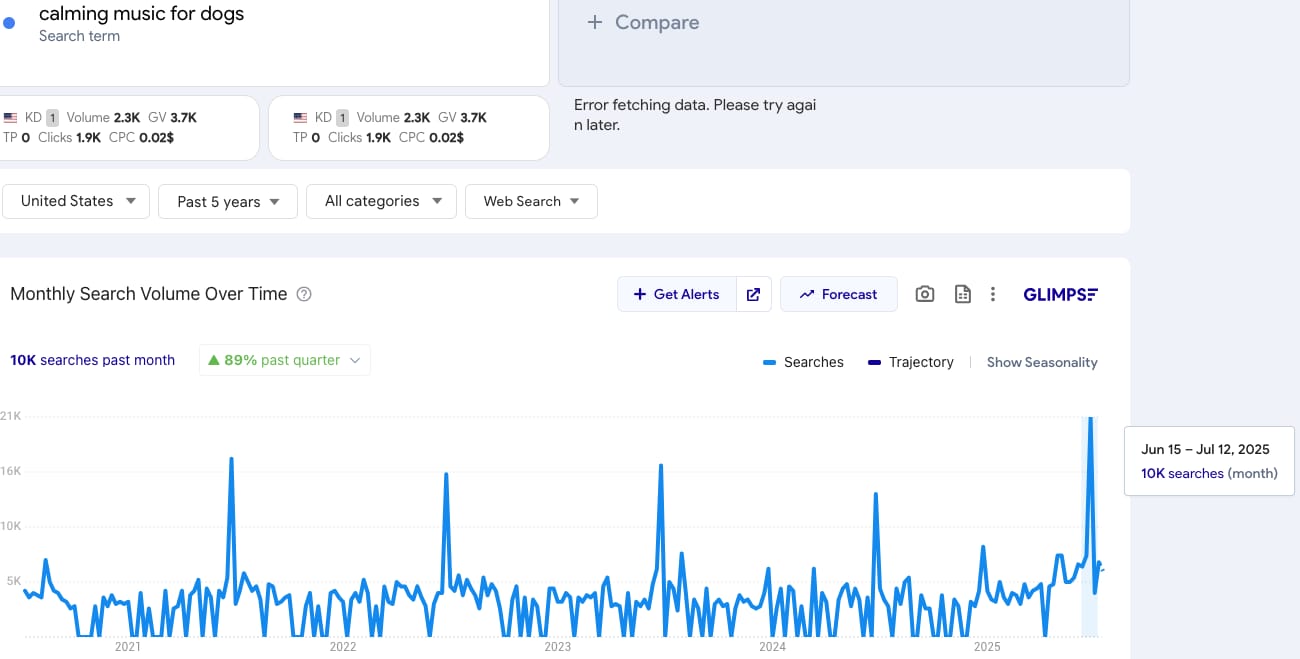
Searches for “calming music for dogs” are hitting new highs, clocking in at 10K searches this past month, an 89% jump from last quarter.
This isn’t just a random spike; it follows a predictable seasonal pattern we’ve seen year after year. Big upticks around summer and winter holidays, likely driven by fireworks, travel stress, and more time spent at home. But this recent surge is the biggest in the past five years, suggesting that anxiety-related pet care, especially digital solutions, is becoming a staple in the modern pet household.
For pet brands, this trend is more than just noise. It signals a growing demand for at-home wellness tools that are low-lift, affordable, and easy to integrate into daily routines.
Whether it’s licensing calming playlists for your app, bundling music into anxiety product kits, or partnering with streaming platforms, there’s opportunity here to turn passive listening into an active revenue stream.
See you Friday!
